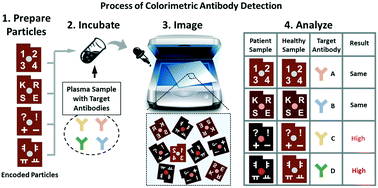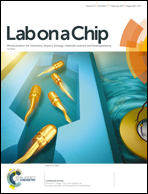Towards encoded particles for highly multiplexed colorimetric point of care autoantibody detection†
Abstract
Highly multiplexed point of care tests could improve diagnostic accuracy and differential diagnostic capacity in for instance emergency medicine and low resource environments. Available technology platforms for POC biomarker detection are typically simplex or low-plexed, whereas common lab-based microarray systems allow for the simultaneous detection of thousands of DNA or protein biomarkers. In this study, we demonstrate a novel suspension particle array platform that utilizes 900 μm bricks for POC amenable colorimetric biomarker detection with an encoding capacity of over two million. Due to the mm-scale size, both the lithographic codes and colorimetric signals of individual particles can be visualized using a consumer grade office flatbed scanner, with a potential for simultaneous imaging of around 19 000 particles per scan. The analytical sensitivity of the assay was determined to be 4 ng ml−1 using an antibody model system. As a proof of concept, autoantibodies toward anoctamin 2 were detected in order to discriminate between multiple sclerosis plasma samples and healthy controls with p < 0.0001 and an inter-assay % CV of 9.44%.



 Please wait while we load your content...
Please wait while we load your content...